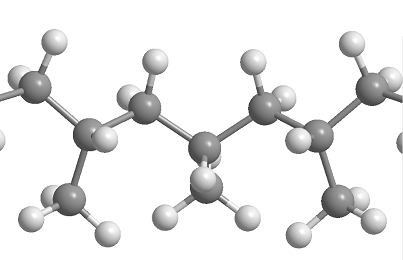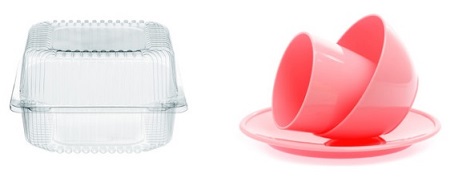Polyethylene

- CAS No.
- 9002-88-4
- Chemical Name:
- Polyethylene
- Synonyms
- PE;PE;PE;hdpe;LDPE;CPE;Ethene, homopolymer;pad522;pes100;polythene
- CBNumber:
- CB5128662
- Molecular Formula:
- (C2H4)n
- Molecular Weight:
- 28.05316
- MOL File:
- 9002-88-4.mol
- MSDS File:
- SDS
- Modify Date:
- 2024/7/2 17:04:22
| Melting point | 92 °C |
|---|---|
| Boiling point | 48-110 °C(Press: 9 Torr) |
| Density | 0.962 g/mL at 25 °C |
| refractive index | 1.51 |
| Flash point | 270 °C |
| storage temp. | -20°C |
| form | powder |
| color | White |
| Specific Gravity | 0.95 |
| Water Solubility | Soluble in acetone and benzene. Insoluble in water. |
| Merck | 14,7567 |
| Dielectric constant | 2.2(Ambient) |
| Stability | Stable, but breaks down slowly in uv light or sunlight. Incompatible with halogens, strong oxidizing agents, benzene, petroleum ether, aromatic and chlorinated hydrocarbons, lubricating oils. |
| IARC | 3 (Vol. 19, Sup 7) 1987 |
| NIST Chemistry Reference | Polyethylene(9002-88-4) |
| EPA Substance Registry System | Polyethylene (9002-88-4) |
SAFETY
Risk and Safety Statements
| Safety Statements | 22-24/25 | |||||||||
|---|---|---|---|---|---|---|---|---|---|---|
| WGK Germany | 3 | |||||||||
| RTECS | TQ3325000 | |||||||||
| TSCA | Yes | |||||||||
| HS Code | 39041090 | |||||||||
| NFPA 704 |
|
Polyethylene price More Price(44)
| Manufacturer | Product number | Product description | CAS number | Packaging | Price | Updated | Buy |
|---|---|---|---|---|---|---|---|
| Sigma-Aldrich(India) | 81223 | Polyethylene analytical standard, for GPC, 2,000 | 9002-88-4 | 100MG | ₹16616.38 | 2022-06-14 | Buy |
| Sigma-Aldrich(India) | 547999 | Polyethylene High density, melt index 2.2?g/10 min (190 °C/2.16kg) | 9002-88-4 | 1KG | ₹5131.05 | 2022-06-14 | Buy |
| Sigma-Aldrich(India) | 434272 | Polyethylene Ultra-high molecular weight, surface-modified, powder, 34-50?μm particle size | 9002-88-4 | 100G | ₹9677.55 | 2022-06-14 | Buy |
| Sigma-Aldrich(India) | 434272 | Polyethylene Ultra-high molecular weight, surface-modified, powder, 34-50?μm particle size | 9002-88-4 | 500G | ₹17579.8 | 2022-06-14 | Buy |
| Sigma-Aldrich(India) | 434264 | Polyethylene Ultra-high molecular weight, surface-modified, powder, 125?μm avg. part. size | 9002-88-4 | 1KG | ₹11463.68 | 2022-06-14 | Buy |
Polyethylene Chemical Properties,Uses,Production
Chemical Properties
Chemical and physical properties are markedly affected by increasing density, which is affected by the shape and spacing of the molecular chain. Low-density materials have highly branched and widely spaced chains, whereas high-density materials have comparatively straight and closely aligned chains. Low-density polyethylene (0.926–0.9409 g/cm3) is soluble in organic solvents at temperatures higher than 200°F. It is insoluble at room temperature. High-density polyethylene (0.041–0.965 g/cm3) is hydrophobic, permeable to gas, and has high electrical resistivity.
Low molecular weight polyethylenes have excellent electrical resistance and resistance to water and to most chemicals. Medium molecular weight polymers are waxes miscible with paraffin wax, and polyethylene polymers whose molecular weights are higher than 10,000 are the familiar tough and strong resins that are flexible or stiff. By varying the catalyst and methods of polymerization, properties such as density, crystallinity, molecular weight, and polydispersity can be regulated over wide ranges. Polymers with densities ranging from approximately 0.910 to 0.925 g/cm3 are low-density polyethylenes; those with densities ranging from 0.926 to 0.940 g/cm3 are medium-density polyethylenes; and those with densities ranging from 0.941 to 0.965 g/cm3 and higher are high-density polyethylenes.

As the crystallinity or density increases, the products generally become stiffer and stronger and have a high softening temperature and high resistance to penetration by liquids and gases. At the same time, they lose some of their resistance to tear and environmental stress cracking.
High-density PE (HDPE) is a chemically pure, porous plastic implant material that can perform supportive functions. The material has good tissue biocompatibility and permits ingrowth of connective tissue with related vascularization. The material is being used more frequently in nasal surgery.
Polyethylene can be cross-linked by irradiation (electron beam, gamma, or X radiation) or by free radical catalysts such as peroxides.
Definition
Polyethylene is a flexible waxy translucentpolyalkene thermoplastic made in avariety of ways producing a polymerof varying characteristics. In the ICIprocess, ethene containing a trace of oxygen is subjected to a pressure inexcess of 1500 atmospheres and atemperature of 200°C. Low-densitypolyethene (r.d. 0.92) has a formulaweight between 50 000 and 300 000,softening at a temperature around110°C, while the high-density polythene(r.d. 0.945–0.96) has a formulaweight up to 3 000 000, softeningaround 130°C. The low-density polymeris less crystalline, being more atactic.Polyethene is used as aninsulator; it is acid resistant and iseasily moulded and blown.
Polyethylene is a water-repellent, white, tough, leathery, thermoplastic resin very similar in appearance to paraffin wax. Properties vary from a viscous liquid at low molecular weights to a hard waxlike substance at high molecular weights. It is used as a coating for glass bottles and fiberglass fabrics (special treatments for glass are required to obtain good adhesion between polyethylene and glass) and is also used as an injection-molding material for ceramics.
In the polymerization process, the double bond connecting the carbon atoms is broken. Under the right conditions, these bonds reform with other ethylene molecules to form long molecular chains. Ethylene copolymers, EVA, and EEA are made by the polymerization of ethylene units with randomly distributed comonomer groups, such as vinyl acetate (VA) and ethyl acrylate (EA).
Uses
Polyethylene (PE) is a thermoplastic polymer consisting of long hydrocarbon chains. PE is used in a number of applications including flexible film packaging produced by the blown film process. Polyethylene is used to regulate viscosity, suspension properties, and general stability in cosmetic formulations. Typical applications included specialty injection molded parts, in these fields Polyethylene has a wide range of uses:
Injection and blow molded toys, housewares and lids.
Injection molded car seats, mower parts and pails.
Injection molded, thin-walled containers and housewares.
Hot melt coating for paper, additive in cast moldings, candles, oil-based inks and hot melt adhesives.
Additive to unsaturated polyesters, epoxides and other polymers to impart the unique properties of UHMWPE. Used in industrial parts, coatings and wear surfaces at 10-40 wt. %.
Film applications having good drawdown and toughness.
Mold release additive, lubricant in rubber processing, extrusion and calendering aid for PVC and dispersing aid for color concentrates.
Bearings, gears, bushings and other moving parts.
Laboratory tubing; in making prostheses; electrical insulation; packaging materials; kitchenware; tank and pipe linings; paper coatings; textile stiffeners.
polyethylene is used to regulate viscosity, suspension properties, and general stability in cosmetic formulations. It is derived from petroleum gas or dehydration of alcohol.

Production Methods
Linear PE is produced by a low-pressure solution or gasphase process that is initiated by a variety of transition metal catalysts. The most common catalysts are Ziegler titanium compounds with aluminum alkyls and Phillips chromium oxide-based catalysts. The gas-phase and slurry processes are used to produce high molecular weight, high-density (HMW-HDPE) products. The highest density linear PEs can be made from an α-olefin comonomer, typically octene for the solution process and butene or hexene for the gas-phase process. Linear PE does not have long-chain branches and is therefore more crystalline. The short-chain branches found in linear PE serve as tie molecules, which give the higher α -olefin copolymers improved puncture and tear properties. Included in the linear PE family are ultra-low-density PE (ULDPE), LLDPE, and HDPE.
HDPE’s main use is in blow-molded products such as milk bottles, packaging containers, drums, car fuel tanks, toys, and houseware. Film and sheet are widely used in wrappings, refuse sacks, carrier bags, and industrial liners. Injection molding products include crates, pallets, packaging containers, houseware, and toys. Extrusion grades are used in pipes, conduit, wire coating, and cable insulation.
LLDPE is a thermoplastic that in many applications replaces its predecessor, low-density polyethylene (LDPE), or is used in blends with LDPE. In particular, LDPE’s shortchain branching gives it higher tensile strength, puncture, and anti-tear properties, making it especially suitable for film applications.
Agricultural Uses
LDPE is short for low density polyethylene. LDPE sheets are used for lining jute bags in which fertilizers are stored. LDPE acts as a waterproofing material.
Safety Profile
Questionable carcinogen with experimental tumorigenic data by implant. Reacts violently with F2. When heated to decomposition it emits acrid smoke and irritating fumes.
Carcinogenicity
IARC reports that data available do not allow the evaluation of carcinogenicity of ethylene in humans. Rats exposed to ethylene by inhalation show no increase in tumor incidence.
Purification Methods
Crystallise it from thiophen-free *benzene and dry it over P2O5 under vacuum.
Polyethylene Preparation Products And Raw materials
Raw materials
Preparation Products
1of6
chevron_right| Supplier | Tel | Country | ProdList | Advantage | Inquiry |
|---|---|---|---|---|---|
| SYNOVA CHEMICALS | +91-9920741772 +91-9920741772 | Mumbai, India | 428 | 58 | Inquiry |
| UNILOSA INTERNATINAL PRIVATE LIMITED | +91-9999069917 +91-9999069917 | New Delhi, India | 152 | 58 | Inquiry |
| MLA Industries | +919336432992 | Uttar Pradesh, India | 20 | 58 | Inquiry |
| Unicorn Petroleum Industries Private Limited | +91-2225299990 +91-9930731710 | Maharashtra, India | 22 | 58 | Inquiry |
| Wax India | +91-2223454601 +91-2223454601 | Maharashtra, India | 3 | 58 | Inquiry |
| Diamines and Chemicals Limited | +91-2653534250 +91-2653534250 | Gujarat, India | 5 | 58 | Inquiry |
| Rubexco Pvt Ltd | +91-9825231936 +91-9909917613 | Gujarat, India | 36 | 58 | Inquiry |
| Goyel Chemical Corporation | +91-8017441678 +91-9038196050 | West Bengal, India | 4 | 58 | Inquiry |
| Girnar Industries | +91-9574413331 +91-9714913331 | Gujarat, India | 10 | 58 | Inquiry |
| S V Plastochem Pvt Ltd | +91-9272227865 +91-9766105292 | Maharashtra, India | 29 | 58 | Inquiry |
| Supplier | Advantage |
|---|---|
| SYNOVA CHEMICALS | 58 |
| UNILOSA INTERNATINAL PRIVATE LIMITED | 58 |
| MLA Industries | 58 |
| Unicorn Petroleum Industries Private Limited | 58 |
| Wax India | 58 |
| Diamines and Chemicals Limited | 58 |
| Rubexco Pvt Ltd | 58 |
| Goyel Chemical Corporation | 58 |
| Girnar Industries | 58 |
| S V Plastochem Pvt Ltd | 58 |
Related articles
- The four commercial grades of polyethylene
- Polyethylene can be prepared in four commercial grades.
- Jan 11,2024





